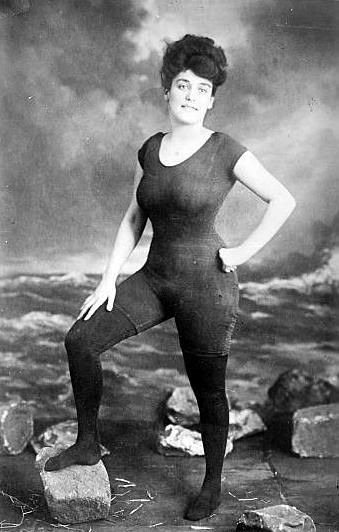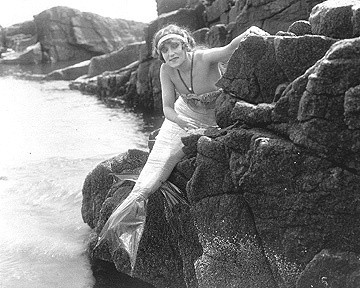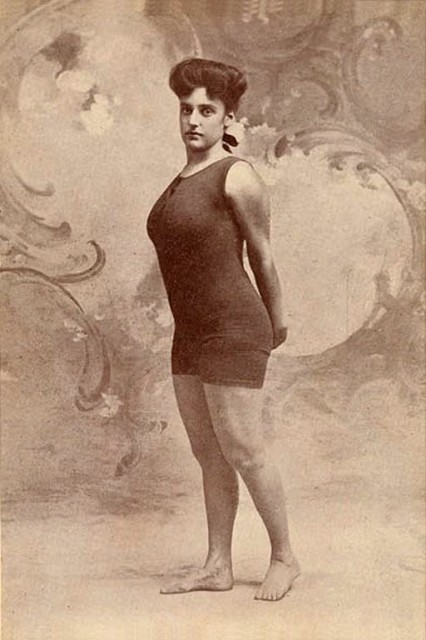Bathing Suit Shopping With Annette Kellerman, the Australian Mermaid
by Cristina Black

It’s the same thing every spring: You peruse the magazines, grit your teeth, and go bathing suit shopping. But when you get into the dressing room, it’s a big old mess. Your limbs are pale, lumpy, mottled, and large-looking. You shouldn’t have eaten so much pasta/drunk so much wine. You should have started around mid-February cutting out carbs/going to the gym. So you head home empty handed, in a haze of disgust and frustration.
Before you get fitted for a burqa, though, think of this: A hundred years ago, you wouldn’t have been in this position, shopping for a bathing suit, because there was no such thing. You would be rummaging through your summer storage trunk for your stockings, bloomers, and sailor dress, which would be made of wool, because that’s actually what women wore to the beach until one lady came along and changed all that. Annette Kellerman, known in her time as “the Australian Mermaid,” was a competitive swimmer, diver, model, actress, stuntwoman, fitness guru, and, yes, professional mermaid in vaudeville and movies, who originally sewed stockings onto a man’s racing suit for less drag in the water. Then, one day, circa 1908, she forewent those old leg coverings and appeared on a Boston beach in a skin-tight onesie with the legs cut off mid-thigh. She was arrested. Later, in court, she explained she was not a provocateur but a pragmatist. She simply wanted to swim freely, and was that so wrong? “I may as well be swimming in chains,” she complained. Before long, she had created her own line of women’s swimwear, when there really was no such thing, and long before celebrities regularly leveraged their fame to sell clothes. The “Annette Kellerman” was the first modern swimsuit for women. And, in many ways, its namesake was one of the first modern women.

By the time of her famous beach arrest, Kellerman, still in her early 20s, was already a world-class swimmer. She had beaten dozens of men in long distance races; swum the Thames, the Seine, and the Danube; and had attempted to cross the English Channel three times — then the only woman who had dared to try — making it three-quarters of the way before succumbing to frigid temperatures and seasickness. “The men wore no clothes, but I was compelled to put on a bathing suit,” she recalled of her first Channel swim. “Small as it was, it chafed me. When I finished, the flesh under my arms was raw and hurt fearfully.”
When long distance swimming failed to pull her and her father-manager out of poverty, Kellerman turned to high-diving in Chicago and quickly became the highest paid act on the vaudeville circuit. Meanwhile, she invented the sport of synchronized swimming with a water ballet performance in a glass tank at the New York Hippodrome. After a 1908 study of 3000 female figures, a Harvard University faculty member named Kellerman “the Perfect Woman” because of the similarity of her physical attributes to the Venus de Milo. She was uncomfortable with the label. “I don’t want to be just a pretty fish,” she complained.

It’s worthwhile to note that Kellerman was not particularly thin by today’s standards. At 5′ 4,” she measured 33 inches in the chest, 26 at the waist. Her hip measurement was never recorded, but from photos, it looks like it never dipped too far south of 40. Most of the bathing-beauty pinups she spawned had similar figures, round-butted and full-thighed, but for a long time, Kellerman was considered the prettiest fish of them all. When she tired of flopping into the water like a trick seal, she parlayed her rising star into a silent film career, becoming the first major actress to do a nude scene (in A Daughter of the Gods in 1916). Later in life, Kellerman became a celebrity fitness guru when there was no such thing, and opened a health food store in Long Beach when everybody still drank whole cow’s milk and ate steak for dinner. She was a vegetarian many decades before it stopped seeming strange. And right up to her death at age 88, she bragged that she could still bend over and touch her toes, a picture of perfect health until the end.
Well into the ’70s, Annette Kellerman swam every day. “There is nothing more democratic than swimming,” she wrote. “Bathing is a society event but swimming out beyond the surf line is just plain social. Every one is happy and young and funny. No one argues. No one scolds. There is no time and no place where one may so companionably play the fool and not be called one.” When she puts it that way, it seems a little silly to think that bathing suit shopping is excruciating for women because we are frightened at the thought of baring so much skin. We forget how fragile is the freedom to go swimming and sunning in clothes that let us feel the water and wind and sun on our skin. Ladies, relish the skimpiness of today’s suits! If it makes you more comfortable, go ahead and wear a maillot cut low on the legs, high in the neck. Just be glad you have a choice.
Cristina Black has written about music, fashion, feminism, and other cultural issues for Village Voice, Time Out New York, Nylon, and Dazed & Confused. She is currently the entertainment editor for surf style magazine Foam. She is also a pianist and ukulele player who writes and sings uncommon pop songs.